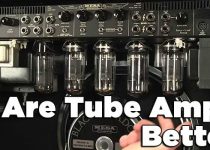9 Way to Fix Guitar Amp Headphone Jack Not Working
Your guitar amp is your creative partner. It helps you shape your unique sound. You plug in your headphones for silent practice. Suddenly, you hear absolutely nothing. A dead headphone jack is a common issue. It frustrates many musicians during late-night sessions. The good news is you can often fix it. This guide shows you how to solve it. We provide simple steps for you to follow.
We explain why your amp’s headphone jack fails. I offer a clear, step-by-step repair to Guitar Amp Headphone Jack Not Working. You can learn some basic electronics skills. This saves you money on costly repairs. Let us get your amp working again. You can return to practicing your music silently. Your family and neighbors will thank you. This fix is easier than you might think.

# Table of Contents =>
- 1 Initial Checks: Guitar Amp Headphone Jack Not Working-
- 1.1 Common Reasons for Guitar Amp Headphone Jack Not Working –
- 1.2 How to Fix The Guitar Amp Headphone Jack Not Working: Step-by-Step
- 1.2.1 A Note on Safety: Discharging Capacitors
- 1.2.2 Step 1: Gather All Your Necessary Tools
- 1.2.3 Step 2: Carefully Open the Amplifier Chassis
- 1.2.4 Step 3: Locate the Headphone Jack Component
- 1.2.5 Step 4: Clean the Jack’s Internal Contacts
- 1.2.6 Step 5: Inspect and Re-Tension Bent Contacts
- 1.2.7 Step 6: Examine the Solder Joints Closely
- 1.2.8 Step 7: Reflow Any Suspicious Solder Joints
- 1.2.9 Step 8: Replace the Entire Headphone Jack
- 1.2.10 Step 9: Reassemble and Test Your Amplifier
- 1.3 Knowing When to Seek Professional Help –
- 1.4 Final Thoughts on Your Amp Repair:
Your Amp’s Headphone Jack:
The headphone jack seems like a simple part. It performs a very important function. It reroutes the amplifier’s signal output. The sound goes from the main speaker. It travels directly to your headphones. This allows you to practice without making noise. Most jacks have a built-in switching mechanism. This switch automatically mutes the main speaker. It activates when you insert a headphone plug.
The jack contains several small metal contacts. These contacts press against the headphone plug. They create a secure electrical connection. The switching contact disconnects the main speaker. This is a crucial mechanical process. Over time, these parts can wear out. They can also become dirty or misaligned. Understanding this helps you diagnose the issue. You can pinpoint the exact point of failure.
Initial Checks: Guitar Amp Headphone Jack Not Working-
Before opening your amp, perform simple checks. These steps can save you a lot of time. Sometimes the problem is not the amp. It could be something much simpler. Let’s walk through these initial diagnostic steps. You should always start with the basics. This process eliminates common external issues.
Step 1: Test Your Headphones and Cable
Your headphones could be the actual problem. This is a very frequent cause. First, unplug them from the amplifier. Plug them into a different audio source. You can use your phone, laptop, or stereo. If you hear no sound, you found it. The issue is with your headphones. You might just need a new pair. If they work, the problem is elsewhere.
Step 2: Inspect the Jack for Debris
Headphone jacks are open to the environment. They often collect dust, lint, and debris. This buildup can prevent a solid connection. Take a flashlight and look inside the jack. Do you see anything obstructing the port? If so, you need to clean it out. Use a can of compressed air first. This can dislodge any loose particles safely. A dry cotton swab can also work well.
Step 3: Check All Amplifier Settings
Sometimes the solution is on the control panel. Make sure your amp’s master volume is up. Check the gain and channel volume knobs. Ensure they are not turned all the way down. Some amps have a standby switch. Confirm the amp is fully on. It seems obvious but is easy to overlook. Review your amplifier’s user manual as well. There may be a specific setting you missed.
Common Reasons for Guitar Amp Headphone Jack Not Working –
If the simple fixes do not work, dig deeper. The problem is likely inside the jack. Several common issues can cause this failure. Understanding these helps you identify the root cause. This knowledge guides your repair approach. Let’s explore the most common culprits now.
Reason 1: Dirty or Oxidized Contacts
Over time, metal contacts can become dirty. They can also develop a layer of oxidation. This film prevents electricity from flowing properly. It leads to crackling sounds or total silence. Dust and moisture accelerate this process. Cleaning the contacts is often the solution. This is a very common issue in older amps. It also happens in humid environments.
Reason 2: Bent or Loose Internal Contacts
The jack’s internal contacts rely on tension. They must press firmly against the plug. Frequent use can cause them to bend. Using the wrong size plug can damage them. If a contact is loose, the connection fails. The signal cannot travel to your headphones. You can sometimes see this by looking inside. A bent contact may be visibly misaligned.
Reason 3: Cold or Cracked Solder Joints
The headphone jack connects to a circuit board. It uses several solder points for connection. A “cold” solder joint is a common defect. It happens during the manufacturing process. The solder does not flow correctly. It creates a weak and unreliable connection. Vibrations and heat can cause it to fail. The joint might also crack over time. This will interrupt the audio signal completely.
Reason 4: A Physically Broken Jack
Accidents can happen in any musical space. Someone might trip over the headphone cable. This can put immense stress on the jack. The plastic housing might crack or shatter. The entire component can break off the board. In this case, cleaning will not help. The only solution is a full replacement. Physical damage is usually very easy to spot. You will see cracks or broken pieces.
How to Fix The Guitar Amp Headphone Jack Not Working: Step-by-Step
Now we move to the hands-on repair. This guide will walk you through the process. Remember to always work carefully and safely. Disconnect your amplifier from all power sources. This is the most important safety precaution. If you are not comfortable, stop immediately. Contact a professional technician for assistance.
A Note on Safety: Discharging Capacitors
Guitar amplifiers use large capacitors. These components store a lot of electricity. They can hold a dangerous charge for hours. This is true even after unplugging the amp. You must discharge them before working. If you are unsure how, do not proceed. Research your specific amp model for instructions. Professional help is the safest option.
Step 1: Gather All Your Necessary Tools
Having the right tools makes the job easier. It also makes the repair much safer. You will need a few essential items.
- Screwdrivers: You will need Phillips and flat-head types.
- Soldering Iron: A 30-watt iron is usually sufficient.
- Solder: Use a rosin-core solder for electronics.
- Desoldering Pump or Wick: This removes old solder.
- Contact Cleaner: An electronics-grade spray is best.
- Needle-Nose Pliers: These help manipulate small parts.
- Replacement Jack: If needed, get the correct part.
Step 2: Carefully Open the Amplifier Chassis
You must access the internal circuit board. Unplug the amp from the wall outlet. Remove all other cables connected to it. Find the screws holding the chassis. They are usually on the back or sides. Keep all screws in a safe place. You do not want to lose any of them. Gently slide the chassis out of the cabinet. Be careful not to snag any wires.
Step 3: Locate the Headphone Jack Component
Look at the main printed circuit board (PCB). The headphone jack is usually near the front. It will be mounted directly to the board. It connects to the front control panel. Trace the path from the external port. You should see its solder points on the PCB. Examine the area closely for any issues. Look for obvious signs of damage or wear.
Step 4: Clean the Jack’s Internal Contacts
First, try a simple cleaning solution. Use a can of electronic contact cleaner. Spray a small amount directly into the jack. Insert and remove a headphone plug. Do this several times to work it in. This action helps scrub the internal contacts. It can dislodge grime and remove oxidation. Let the cleaner evaporate completely before testing.
Step 5: Inspect and Re-Tension Bent Contacts
Look inside the jack with a good light. You should see small metal spring contacts. They should be straight and aligned properly. If one looks bent, you must fix it. Use a small pick or needle-nose pliers. Carefully bend the contact back into place. Be very gentle to avoid breaking it. The goal is to restore firm pressure. It needs to touch the headphone plug.
Step 6: Examine the Solder Joints Closely
Flip the circuit board over carefully. Find the solder points for the jack. A good solder joint looks shiny and smooth. A cold joint looks dull, gray, or cracked. It may have a fractured or crystalline texture. Look for a ring-like crack around the pin. This is a clear sign of a failed joint. All joints should look solid and uniform.
Step 7: Reflow Any Suspicious Solder Joints
Reflowing the solder can fix a bad joint. It involves reheating the existing solder. This allows it to flow and form a new bond.
- Turn on your soldering iron to heat up.
- Clean the tip of the iron on a damp sponge.
- Place the tip on the joint, touching the pin and pad.
- Apply a tiny amount of new solder.
- Remove the iron and let the joint cool.
- The new joint should look shiny and cone-shaped.
Step 8: Replace the Entire Headphone Jack
If the jack is broken, you must replace it. This requires desoldering the old component.
- Heat each solder joint with your iron.
- Use a desoldering pump to suck up the molten solder.
- A desoldering wick can also absorb the solder.
- Gently wiggle the old jack free from the board.
- Insert the new jack into the empty holes.
- Solder each pin to the circuit board.
- Ensure each new joint is clean and solid.
Step 9: Reassemble and Test Your Amplifier
Once the repair is complete, reassemble your amp. Put the chassis back into the cabinet. Secure it with all the original screws. Do not overtighten them and strip the threads. Plug the power cord back into the wall. Turn the amplifier on with the volume down. Plug your headphones in and test the sound. Slowly turn up the volume to check it.
Knowing When to Seek Professional Help –
DIY repairs are not for everyone. It is important to know your limits. You can cause more damage if you are unsure. This can lead to a more expensive fix. If you open the amp and feel lost, stop. If you see burned components, seek help.
A qualified technician has the right tools. They also have the experience to diagnose complex issues. Your amp is a valuable piece of gear. Sometimes professional service is the best investment.
Final Thoughts on Your Amp Repair:
Fixing a headphone jack is very rewarding. Hopefully you got the Guitar Amp Headphone Jack Not Working and fixed. It is a great introduction to amp maintenance. By following these steps, you can solve the problem. You can get back to your silent practice sessions. Always remember to prioritize your safety. Unplug the amp and discharge the capacitors.
Work slowly and methodically through each step. A little patience goes a long way. Enjoy the satisfaction of fixing your own gear. Now you can play your guitar anytime you want. You will not disturb anyone around you.
Last Updated on September 21, 2025 by Perry Garner


